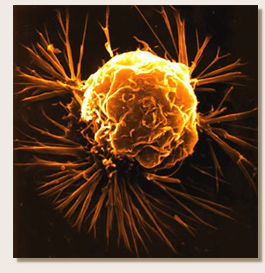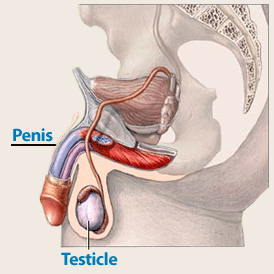In Brief... Testicular cancer is the most common
cancer in young men between the ages of 15 and 40 years old and is
almost always curable if it is found early. Most testicular cancers are
found by men themselves, either as a painless lump, a hardening or
change in size of the testicle, or pain in the testicle. Testicular
cancer can be treated with surgery, radiation therapy, chemotherapy,
surveillance, or a combination of these treatments.
What is Cancer?
 Cancer is a
group of more than 100 diseases. Although each kind differs from the
others in many ways, every type of cancer is a disease of some of the
body's cells. Healthy cells that make up the body's tissues grow,
divide, and replace themselves in an orderly way. This process keeps
the body in good repair. Sometimes, however, some cells lose the
ability to limit and direct their growth. They grow too rapidly and
without any order. Too many cells are produced, and tumors are formed.
Tumors can be either benign or malignant.
Cancer is a
group of more than 100 diseases. Although each kind differs from the
others in many ways, every type of cancer is a disease of some of the
body's cells. Healthy cells that make up the body's tissues grow,
divide, and replace themselves in an orderly way. This process keeps
the body in good repair. Sometimes, however, some cells lose the
ability to limit and direct their growth. They grow too rapidly and
without any order. Too many cells are produced, and tumors are formed.
Tumors can be either benign or malignant.
Benign tumors are not cancer. They do not spread
to other parts of the body and are seldom a threat to life. Benign
tumors can often be removed by surgery, and they are not likely to
return. Some tumors of the testicle are benign, but most are not.
Malignant tumors are cancer. They can invade and
destroy nearby healthy tissues and organs. Cancerous cells can also
spread, or metastasize, to other parts of the body and form new tumors.
Cancer that develops in a testicle is called
testicular cancer. When testicular cancer spreads, the cancer cells are
carried by blood or by lymph, an almost colorless fluid produced by
tissues all over the body. The fluid passes through lymph nodes, which
filter out bacteria and other abnormal substances such as cancer cells.
Doctors use CT (computed tomography) scans of the abdomen and chest to
help determine if the cancer has spread to the lymph nodes or lungs.
What is
Testicular Cancer?
Testicular cancer is one of the most common cancers in young men
between the ages of 15 and 35, but the disease also occurs in other age
groups, so all men should be aware of its symptoms. While testicular
cancer is common among young men, young men typically do not get a lot
of cancer, so overall testicular cancer is a relatively rare disease.
 In the year 2000, an estimated 7,600 cases of testicular
cancer will be diagnosed in the United States, and a little less than
400 of them will die. Caucasians are more likely to get it than
Hispanics, and much more likely to get it than Blacks or Asians. The
instance of testicular cancer around the world has basically doubled in
the past 30-40 years.
In the year 2000, an estimated 7,600 cases of testicular
cancer will be diagnosed in the United States, and a little less than
400 of them will die. Caucasians are more likely to get it than
Hispanics, and much more likely to get it than Blacks or Asians. The
instance of testicular cancer around the world has basically doubled in
the past 30-40 years.
Most testicular cancer cases are found by men
themselves when doing a self-examination or by accident. The testicles
are smooth, oval-shaped, and rather firm. Men who examine themselves
routinely become familiar with the way their testicles normally feel.
Any changes in the way they feel from month-to-month should be checked
by a doctor, preferably a urologist.
In men under 60, 95% of testicular tumors
originate in the germ cells, the special sperm-forming cells within the
testicles. These tumors fall into one of two types, seminomas or
nonseminomas. (Note that in the UK and a few other places, nonseminomas
are called teratoma instead.) Other forms of testicular cancer include
leydig and sertoli cell tumors. Rarely tumors such as PNET,
leiomyosarcoma, rhabdomyosarcoma, mesothelioma and others can arise in
the testicle. Men over the age of 60 can still get a germ cell tumor,
but they are more likely to get leukemia, lymphoma, or a benign tumor
called spermatocytic seminoma. Unless otherwise noted, all the
information on this web site concerns testicular germ cell tumors.
- Pure Seminomas account for about 40 percent
of all testicular cancer and are made up of immature germ cells.
Usually, seminomas are slow growing and tend to stay localized in the
testicle for long periods.
- Nonseminomas are a group of cancers that
often occur in combination with one another, including choriocarcinoma,
embryonal carcinoma, immature teratoma and yolk sac tumors.
Nonseminomas arise from more mature, specialized germ cells and tend to
be more aggressive than seminomas.
